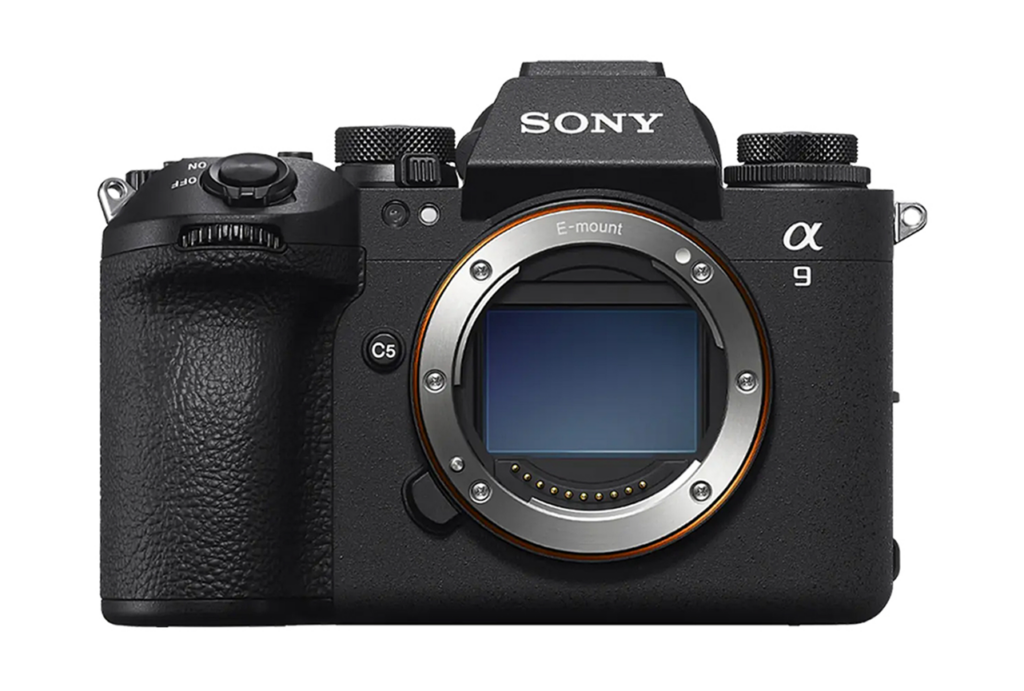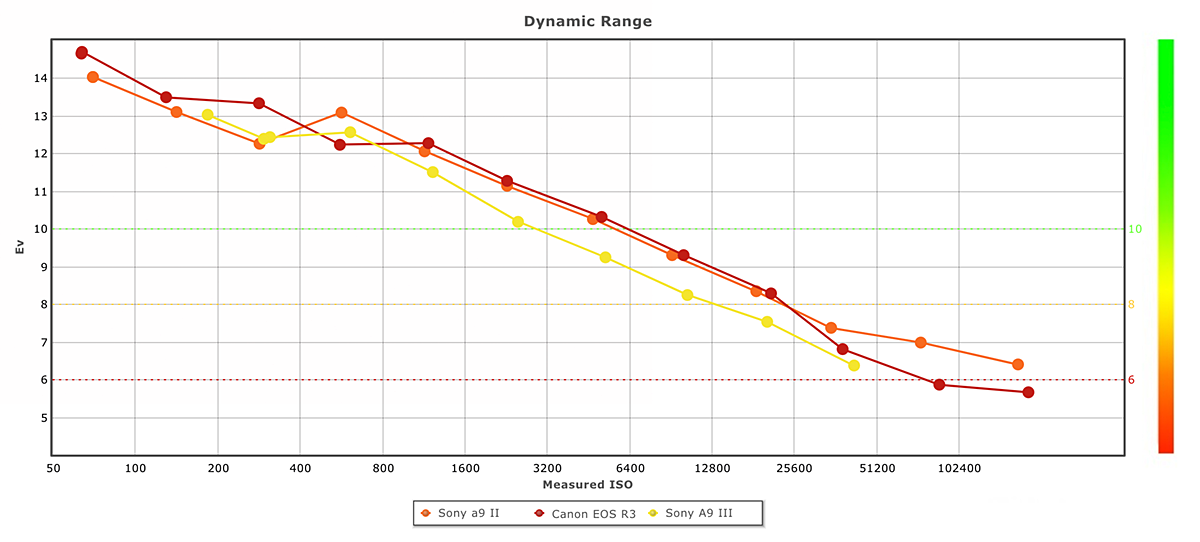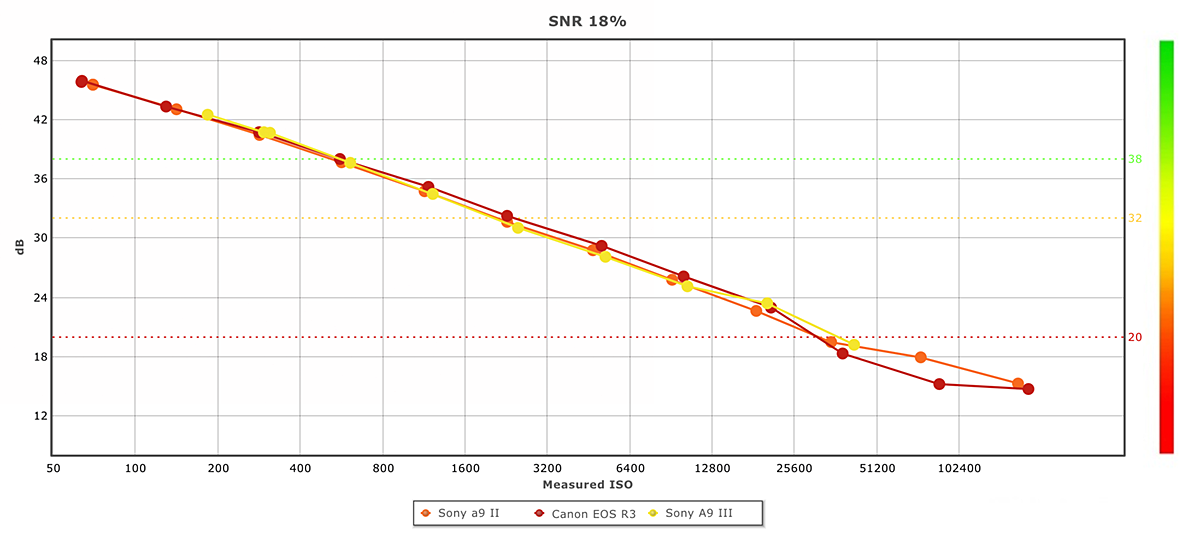Sony has launched the Alpha 9 III (a9 III), featuring the world’s first full-frame global shutter image sensor, enabling burst shooting at up to 120 fps without motion distortion. The camera boasts approximately 24.6 MP and utilizes the BIONZ XR image processing engine for blackout-free continuous shooting with autofocus (AF) and autoexposure (AE). Its advanced autofocus system performs up to 120 calculations per second, enhancing subject recognition and tracking, including improved eye detection.
The Sony a9 III has a maximum shutter speed of 1/80,000 second and supports flash synchronization at all speeds. A 5-axis in-body image stabilization system supports up to 8 stops of camera-motion compensation. It can capture up to 390 Fine JPEG images in a single 30 fps burst, offering customizable focus areas and enhanced AF precision down to EV-5.
For video, the Sony a9 III records 4K at 60 fps from 6K, 120 fps without cropping and supports S-Log3 and S-Cinetone for improved skin tones and highlights. The camera includes a 4-axis multi-angle LCD, a high-resolution electronic viewfinder, and an enhanced ergonomic design for comfortable handling.
Connectivity features include fast FTP transfer capabilities and compatibility with mobile apps for efficient workflow management. The a9 III is designed to meet the demands of professional sports photographers and videographers. It is available now at around $6000/7000€, and its predecessor, the a9 II, will stay in range as a more accessibly priced model.
Key specifications:
- 24.6 MP “stacked” CMOS sensor with electronic global shutter
- Native ISO 250-25,600, with expansion to ISO 125– 51,200
- Blackout-free shooting at 120 fps with full AF / AE (lens dependent)
- 5-axis IBIS (up to 8 stops of camera-motion compensation)
- 9.44m-dot 0.90x OLED electronic viewfinder
- 3.2-in (2.1 m-dot) 4-axis touchscreen
- 4K 60p plus 120p without cropping
- RJ45 (Ethernet), HDMI, Wi-Fi 5, and USB-C (3.2 Gen 2 power/data)
- Twin CFexpress A / SD UHS-II card slots
Overall performance
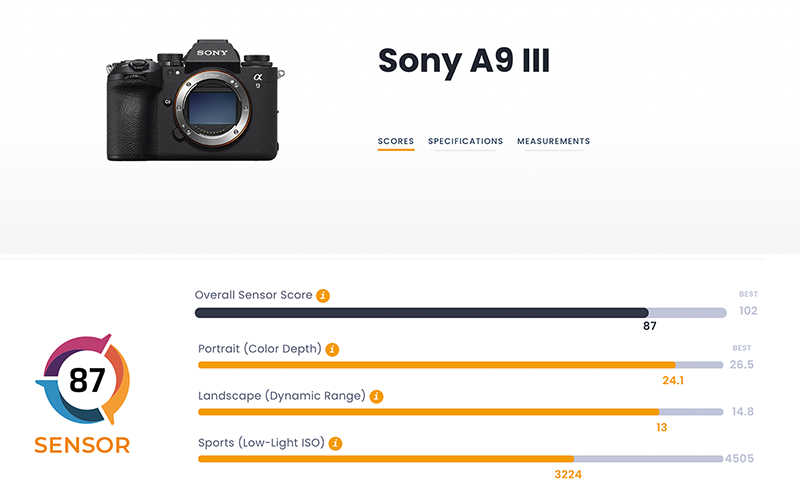 Click on the score chart above to open the Sony a9 III product page.
Click on the score chart above to open the Sony a9 III product page.
The global sensor adopted by the Sony a9 III achieves a relatively respectable DXOMARK score of 87. However, at joint 16th place in our rankings, the score indicates some compromises in sensor performance, most likely due to additional electronics required for the electronic shutter and emphasis on capture rate with autofocus.
The Sony a9 III sensor returned a maximum color depth of 24.1 bits at its extended sensitivity setting of ISO 125. Given the base sensitivity is ISO 250, that’s perhaps not unexpected. The maximum dynamic range is also lower, again mostly due to that higher base sensitivity.
The Sony a9 III achieves a peak dynamic range of 13 EVs, still a good result but slightly down on the conventional progressively read BSI stacked CMOS sensors used in the Canon EOS R3 and the Sony a9 III, which offer over +1 EV more at their base ISO setting. Compared with rivals in this class, there’s also a slight lag in the performance of the Sony a9 III sensor in the Low-light ISO (Sports) category. Nevertheless, the computed value of ISO 3224 is high and on a par with the Sony A1 (ISO 3163).
Image quality compared
Compared with the score of its predecessor, the a9 II, at 93 points, the newer Sony a9 III is marginally behind in terms of sensor performance. The a9 III also follows the Canon EOS R3 sensor, which achieved a highly competitive 96 points in our DXOMARK scoring.
A maximum dynamic range of 13 EVs might seem a little low but it’s still a respectable figure in a highly competitive field. The Sony a9 III is slightly down on the progressively scanned electronic shutter option of the BSI stacked CMOS sensors used in the sports photographers’ favorite Canon EOS R3 and the Sony a9 II, which offer over +1 EV more at their base ISO setting. Both the Nikon Z8 and Z9 also have a wider maximum dynamic range at 14.2 and 14.4 EVs, respectively.
Color depth is also impacted somewhat when used at base (ISO 250). However, with a peak 24.1 bits at the extended setting of ISO 125, the Sony a9 III is more in keeping with rivals. Fortunately, at higher ISOs the disparity is lower and helps in a low-light environment.
In our Low-light (Sports), the computed value of ISO 3224 for the Sony a9 III is relatively high. Notably, it is ahead of the rival mirrorless models, the Nikon Z9 (ISO 2451), Nikon Z8 (ISO 2548), and Canon EOS R5 (ISO 3042). However, while it’s practically identical to another favorite of sports photographers, the 20.2 MP Canon EOS-1D X Mark III DSLR at ISO 3248, it’s still behind the Canon EOS R3 (ISO 4086), the class-leader in this arena.
In-depth comparisons
With the global shutter sensor in the Sony a9 III optimized for high-speed capture and a prerequisite for fast-action and sports, we have pitched it against its closest rival, the 24 MP Canon EOS R3. It was introduced in 2024 at around $5,999. Although the Canon features a BSI stacked CMOS sensor, it, like the a9 II, utilizes progressive scanning when set to the electronic shutter option, meaning the sensor reads the image data line by line in a sequential manner. Even so, the Canon ESO R3 remains highly competitive and capable of AF and AE at up to 30 fps. A firmware update, released after its launch, allows continuous shooting at up to 195 fps, albeit with the AE and AF locked after the first exposure. As it’s another formidable model, we’ve also elected to look at the a9 III’s forerunner, the Sony a9 II, to see where any changes have been made. It is being kept in the range of $4,499, and it remains an attractive option for such a capable action and sports camera.
Portrait (color depth)
The Sony a9 III sensor is weakest in color sensitivity at its lowest ISO settings, but it’s important to recall the sensor’s base sensitivity (ISO 250) is higher than its predecessor, the Sony a9 II and the Canon EOS R3, which are both ISO 100. Bear in mind also that the intended use for this camera – sports and fast-action – is somewhat at odds with selecting low-sensitivity settings most of the time. That said, the extended low sensitivity option ISO 125 (ISO 180 measured) of the Sony a9 III isn’t a ‘faux’ ISO setting like that of its predecessor, the Sony a9 II, and Canon EOS R3. The measured 24.1 bits maximum, against the slightly deeper 25 bits of the Sony a9 II and Canon EOS R3 at their base is still a good result. Indeed, when comparing all three at ISO 200, and upwards to ISO 12,800 they share practically identical color depth. At ultra-high sensitivities from ISO 25,600 to ISO 51,200, though, the Sony a9 III sensor slightly outperforms both the Canon and the Sony a9 II. While this difference might be subtle in many situations, the additional bit depth could offer a marginal advantage in color accuracy and smoothness in tones. Also worth noting is that the Sony a9 III’s color depth stays within our high-quality threshold of 14-bits at ISO 25,600.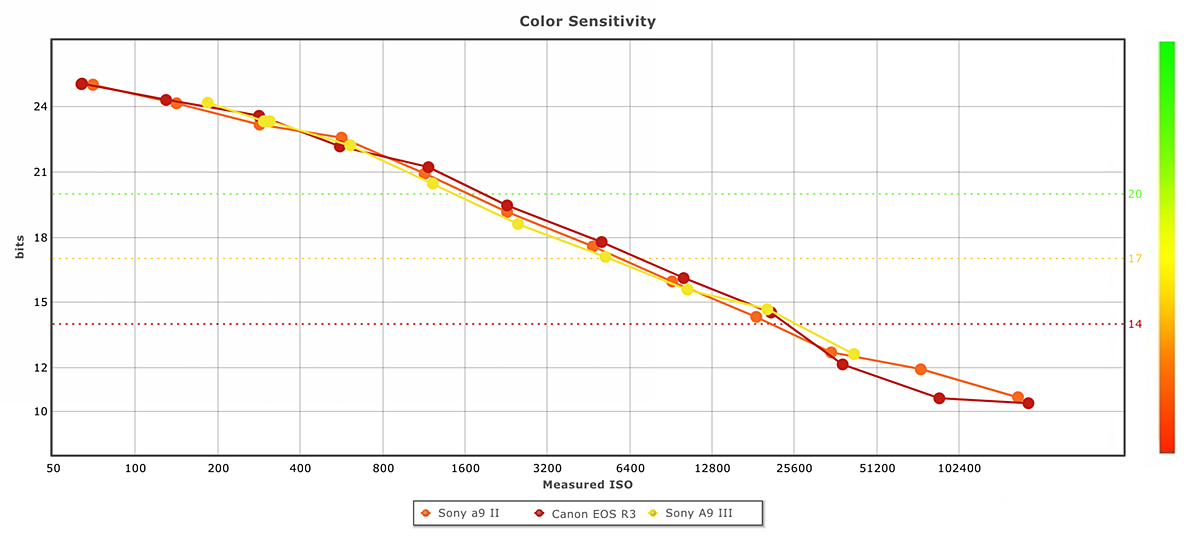
Landscape (dynamic range)
Sports and action-oriented cameras aren’t likely to place priorities on maximizing dynamic range at low ISOs either. However, the global shutter sensor in the Sony a9 III achieves a respectable 13 EVs at ISO 125, even if it is trailing the Sony a9 II sensor’s 14 EVs at ISO 100. The best of the three here is the Canon EOS R3, which has a maximum dynamic range of 14.7 EV at its base sensitivity (ISO 100).
Given that sports-oriented cameras are likely to be used at high sensitivities it’s noteworthy that the Sony a9 III’s ability to remain above 12 EVs dynamic range up to ISO 800. At higher sensitivities, the dynamic range declines at around 1 EV per 1 EV increase in sensitivity up to ISO 51,200. Also interesting is that the Sony a9 III maintains a dynamic range of just over 6 EVs (6.36 EV), and our minimum quality standard for this metric, at its maximum extended sensitivity of ISO 51,200.
Sports (low-light ISO)
In low-light ISO performance, where we compute a maximum value from a minimum standard for color depth and dynamic range, the Sony a9 III achieves a respectable value of ISO 3224. While that is down a little against the Sony a9 II sensor at ISO 3434, the sensitivity difference is negligible at just -0.1 EV. However, when compared with the Canon EOS R3, the Sony a9 III is lower than the Canon sensor’s class-leading ISO 4086. That equates to a difference of -0.35 EV and means that Canon EOS R3 offers a modest advantage in low-light conditions, with slightly cleaner images and reduced noise. However, all three models just miss our minimum 20dB quality threshold for noise levels at ISO 51,200.
Conclusion
From a technical perspective, Sony’s rapid iteration of its cameras is truly remarkable. The introduction of the innovative global shutter sensor in the Sony a9 III offers clear advantages for action and sports photographers. This sensor is highly optimized for operational speed, enabling not just high-speed capture while also supporting autofocus (AF), auto exposure (AE), but also flash synchronization up to 1/80,000 second shutter speed. However, there is a slight trade-off in terms of image quality, with a modest reduction in color depth and dynamic range. As this primarily occurs at low ISOs, it may not be a significant concern. Even if the Sony a9 II and Canon EOS R3 remain competitive in image quality across the sensitivity range, the Sony a9 III still stands out as an impressive alternative. The global shutter sensor greatly enhances the versatility of the Sony a9 III, making it a compelling choice for fast-action photographers.
In this review, we have compared the Sony a9 III to its most relevant rivals from other brands. As usual, you can create your own comparisons and in-depth analyses using our interactive image sensor ranking tool.


